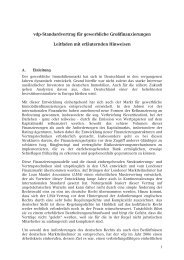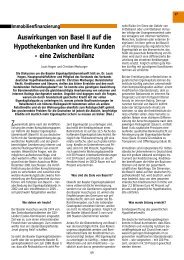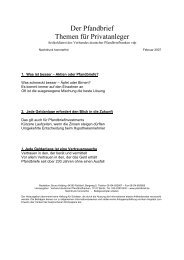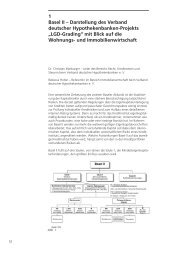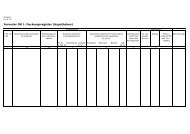The Pfandbrief 2011 | 2012
The Pfandbrief 2011 | 2012
The Pfandbrief 2011 | 2012
Create successful ePaper yourself
Turn your PDF publications into a flip-book with our unique Google optimized e-Paper software.
<strong>The</strong> Methodologies of the Rating Agencies<br />
Standard & Poor’s Rating Services rates covered bonds based on its criteria published in late 2009. S&P’s<br />
criteria reflect its belief that covered bonds that exhibit mismatches between the underlying assets and the<br />
covered bond liabilities should be linked to the issuer credit rating. Only if a covered bond can be isolated from<br />
that risk can S&P rate the covered bonds on a de-linked basis from the issuer. When a program is exposed to<br />
asset-liability mismatch (ALMM) risk, the maximum potential rating uplift the covered bond rating can achieve<br />
above the issuer credit rating is seven nothes. <strong>The</strong>refore, ‘AAA’ ratings can only be assigned to covered bonds<br />
of highly rated issuers, provided that S&P believes the program has sufficient credit enhancement to cover all<br />
relevant risks.<br />
Asset analysis<br />
<strong>The</strong> underlying cover pools typically contain residential mortgage loans, public sector bonds and loans, or<br />
some other form of high credit-quality collateral. Thus, in case of a default a high rate of asset recovery can<br />
be expected. However, the cover pool assets may be exposed to payment interruptions and defaults. <strong>The</strong>refore,<br />
using jurisdiction- and asset-specific assumptions, S&P analyses these pools to form a view on the expected<br />
stressed credit performance. S&P currently reviews the assumptions applied in the asset analysis of public<br />
sector covered bonds.<br />
162<br />
Cash-Flow and Market Value Analysis<br />
In addition to interest and exchange rate mismatches there is an inherent maturity mismatch between the<br />
cover pool assets and the covered bonds. Analysing the degree of this mismatch together with the potential<br />
repayment options is an important step in S&P’s cash-flow- and market value analysis for covered bonds. If the<br />
cover pool fails to generate sufficient cash-flows, S&P models the sale of the remaining cover pool assets by<br />
discounting their cash flows using a stressed discount rate and an asset specific liquidity premium.<br />
We also evaluate the alternatives at the trustee’s disposal to manage ALMM in case of an issuer default.<br />
<strong>The</strong> broader the range of funding options and the more well-established and systemically important S&P<br />
believes the covered bond market is the higher is the potential rating uplift the covered bond rating can<br />
achieve above the issuer credit rating.<br />
Lastly, S&P determines a rating on the program that reflects the cover pool’s actual level of credit enhancement.<br />
In this step, S&P assesses whether the available credit enhancement in a program is equal to or higher<br />
than the target credit enhancement deemed commensurate to support the maximum potential rating. <strong>The</strong> target<br />
credit enhancement covers all risks that S&P considers relevant and in our view allows for timely payment<br />
of all covered bond liabilities.<br />
S&P publishes the main indicators of the covered bonds it rates in a quarterly report (see “Global Covered<br />
Bond Characteristics and Rating Summary” on www.standardandpoors.com/coveredbonds).<br />
Legal Risk<br />
S&P typically reviews the following legal aspects when assigning a rating to a covered bond program – with<br />
special regard to the case if the issuing bank fails:<br />
— Is there a clear segregation of the assets and cash flows;<br />
— Does no acceleration of payments to noteholders of the program occur;<br />
— Are covered bonds excluded from the payment moratorium or forced restructuring of the bank;<br />
— Is the provided credit enhancement fully available to covered bond holders;<br />
— Are hedging instruments still available after the insolvency of the bank;<br />
— What options has the trustee available to access liquidity; and<br />
— What options are available to manage the cover pool.<br />
Operational and Administrative Risks<br />
In its rating process S&P also considers the relevant operational and administrative risks. Hereby, we review<br />
the organisational aspects of the bank, as well as the credit life cycle of the respective assets. <strong>The</strong> issuer’s business<br />
policy, origination and servicing operations, together with recovery following a default are all assessed.<br />
Counterparty Risks<br />
To the extent a program benefits from the use of derivatives to address any interest rate or currency mismatches<br />
S&P reviews the underlying agreements to assess whether they conform with its relevant counterparty<br />
criteria. <strong>The</strong> covered bond specific counterparty criteria are currently under review.<br />
S&P methodology may change from time to time as a result of market and economic conditions<br />
that would affect our credit judgment. S&P currently reviews its counterparty criteria for covered bonds.<br />
(Editor‘s Note: This article is a summary of the S&P criteria published in late 2009 (“Revised Methodology And Assumptions<br />
For Assessing Asset-Liability Mismatch Risk In Covered Bonds” published on Dec. 16, 2009 and available on RatingsDirect and<br />
www.standardandpoors.com/coveredbonds.)<br />
Contacts:<br />
Primary Credit Analyst: Sabrina Miehs, Frankfurt, (49) 69-33-999-304; sabrina_miehs@standardandpoors.com<br />
Analytical Manager - Covered Bonds: Karlo Fuchs, Frankfurt, (49) 69-33-999-156; karlo_fuchs@standardandpoors.com




